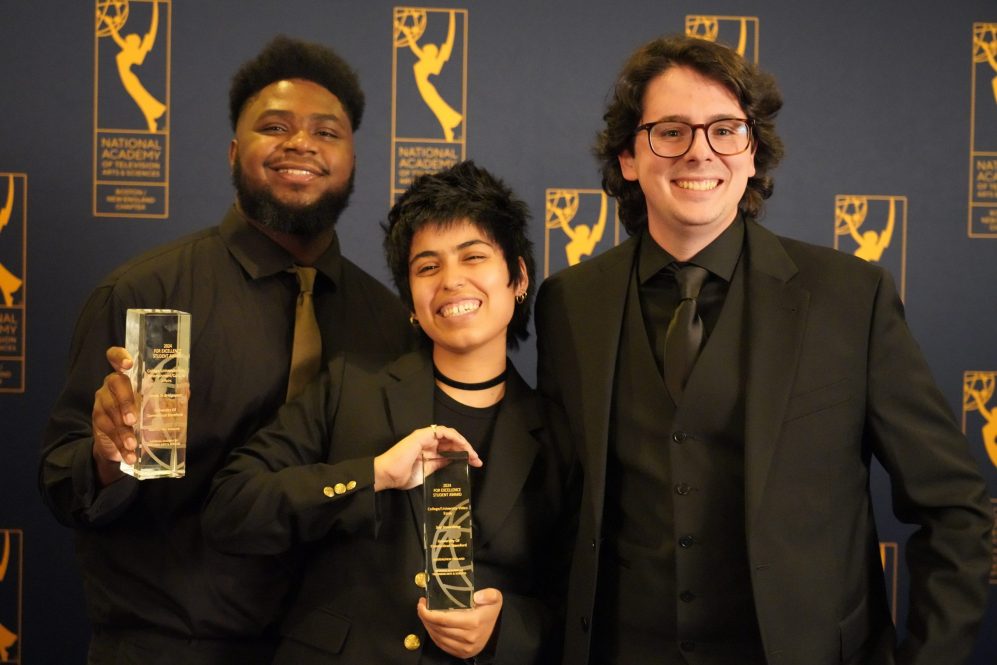When the undergraduate seniors studying in UConn Stamford’s digital film and video production concentration start preparing for their capstone projects, their professor advises them to go personal.
“When they pitch me an idea, and they say, ‘Oh, I want to do the next Marvel movie,’ I’m like, man, you have no budget,” says Oscar Guerra, an Emmy-award winning documentary filmmaker and associate professor of film and video production.
“But use the capital you have. And the capital you have is telling your own story.”
It’s a challenge to share your own story – it means you have to be vulnerable. And you’ll undoubtedly be critiqued – by your professor, by your peers, by your audiences – along the way, something made all the more difficult by that oh-so-personal investment in the story.
But it’s also an opportunity, says Guerra, for a young filmmaker to write their own narrative.
And to learn a valuable lesson about trust – trust in your mentors; trust in those working alongside you; and trust that, when you tell a great story, it will resonate.
A group of young filmmakers at UConn Stamford embraced that challenge in their senior year, offering their own personal stories through a budding partnership with Connecticut Public that’s brought their work to an entirely new audience.
And they’ve racked up accolades for their efforts, most recently at the 47th Boston/New England Emmy® Awards Gala – not only notching wins for the hard-earned skill demonstrated through those personal projects, but also recognition for the young film program at the UConn School of Fine Arts.
New and Growing
The University launched its digital film and video production concentration through the Digital Media and Design program in 2019 with the addition of two new faculty, including Guerra.
“It’s wild to me that there was no film major until then,” says Heather Elliott-Famularo, an award-winning filmmaker and head of the Digital Media and Design department, or DMD, at UConn Stamford and UConn Storrs. “At a Research 1, flagship university, it’s kind of was crazy that there wasn’t even a film production option at UConn.”
Now, students in both Storrs and Stamford can choose a concentration in film as they pursue a Bachelor of Fine Arts, or BFA.
Just five years into the program, the film concentration has become one of the most popular DMD offerings in Storrs, says Elliott-Famularo, where the program is currently home to about 50 undergraduate film students.
But it’s at UConn Stamford – with its close proximity to New York, with a blossoming industry in the city of Stamford itself, and where UConn’s program will soon be expanding to offer narrative as well as documentary production – that the program’s growth has really been on display.
“There’s real grassroots efforts to build the film industry within the state of Connecticut,” says Elliott-Famularo. “That we can have a key role, as the flagship university, is really exciting for us, for the students, and for the industry – it’s a real way that we can give back to the creative economy of the state in helping to prepare these students for their careers.”
The film program in Stamford offers a more intimate experience – the classes are smaller, and students work even more closely with their professors.
They also work closely with each other, which is by design.
“Film is, inherently, a very collaborative process,” says Elliott-Famularo. “You have a crew. You have a cast. Occasionally we make films as one person. We’ve all done it. But ideally, you have a really collaborative group.”
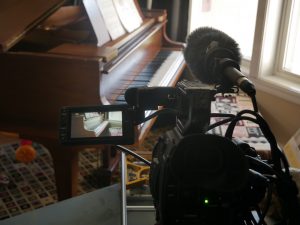
And that’s part of what’s made it so special, according to Agustina Aranda ’23 (SFA), one of the first students to pursue the film concentration at UConn Stamford when the program began in 2019.
“Stamford is just so intentional about teamwork – they really put that in the front,” says Aranda. “No shade to UConn Storrs, I guess. But I just know that I thrive with Stamford.”
Thriving in Stamford
Aranda and her classmates in the first film production cohort at UConn Stamford started in the brand-new program right as UConn students in every school and major were about to feel the impact of the global pandemic.
“It was wild, because we basically worked all the theory portion online,” says Guerra. “That was one of the biggest challenges when we went online for the production classes – it was very challenging to do high-end production.”
Physical distance during the start of the program, however, didn’t stop the cohort from connecting.
Rather, the classmates formed some uniquely tight bonds, each leaning into their own strengths and skills as they collaborated on their own individual projects as well as their group ideas.
“The part that I love the best was working on stuff together,” says Christopher Orrico ’23 (SFA), a member of the inaugural cohort. “Because when you’re working on your individual project, and you’re doing everything yourself, it can get a little stressful, and obviously it takes a lot more time. But when you’re working together with such a talented group of people, then it’s a lot easier to get stuff done.”
What they got done was a series of short productions in which each member of the cohort – Aranda, Orrico, Jayvell Gray ’23 (SFA), Shannon Nasution ’23 (SFA), and Yazmine Uvidia ’23 (SFA) – contributed and collaborated toward the ultimate end-goal of creating high-end documentary films.
Their work also was the first slated to be distributed through a new collaboration between UConn’s DMD program and Connecticut Public called UConn Reels.
“PBS Connecticut was really committed to finding ways to work with us,” says Guerra, who’s produced multiple documentaries for PBS Frontline and who worked to start discussions with the network to find ways to collaborate. “They really liked the idea, because it’s not just that they want content, they want good content. So, it was just a matter of everyone getting connected to see the type of work that we’re doing.”
The cohort ultimately produced five short documentaries that published online and aired on the broadcast channels through UConn Reels – largely Connecticut-centric stories, ranging from a profile of the local indie-pop band Similar Kind; to an examination of the once-thriving, now-waning skateboard culture in Bridgeport; to a glimpse into the innovative Bridgeport fashion scene pioneered by Black and brown designers, models, and promoters.
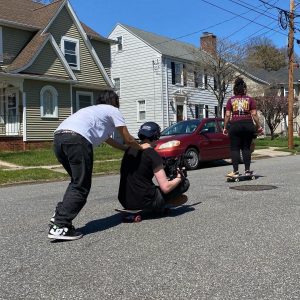
For each project, the students used their relationships with each other to develop concepts, film, edit, refine, and ultimately distribute their collaborative work.
“For ‘Made In Bridgeport,’ specifically, it was a group project,” says Orrico. “Agustina directed. I filmed the entire thing – that’s kind of usually what I do. I film most of the projects. I’m the cam person and the technical person, and Jayvell edited. We all had our roles, and sometimes we collaborated even more. Hey, what do you think of this? What can we do better? What could we change? It was a great group effort.”
But they also shared those personal stories – the ones where they had to be vulnerable and allow themselves to be present in the work.
For Aranda and Orrico, those came through vastly different portraits of their fathers. Aranda’s “Say Something” offers an intensely intimate look at the de-evolution of a father-daughter relationship portrayed through interview, archival footage, and animation.
For Orrico, “The Ladder” explains the events that helped shape his own father’s life and shares the lessons of that life that are now passed onto new generations within their family.
For each of them, their willingness to share such personal aspects of their lives was made easier by the relationships they’d developed with their teachers and classmates.
“I think being vulnerable came kind of easy,” Aranda says, “because I knew these guys for my entire college career, and I knew the guidance they’d given me and would give me, if I wanted to do this.”
“We’re friends at this point,” says Orrico. “We had built this relationship, and we knew what each of us was good at. In terms of Agustina and myself, she was like, I’ll direct something and you film it. And I’m there for it. I know my strengths. I know her strengths. And it’s just really important to trust.
“Sometimes, working with other people, it can make or break something. So, trust was very much the biggest thing.”
Accomplishment and Acclaim
Aranda, Orrico, and their classmates all graduated from UConn in 2023, and they were no longer students when their films first appeared through UConn Reels. Though they’ve moved on to different pursuits – Aranda and Orrico are both currently working in different roles at ITV America in Stamford – their student work continues to achieve acclaim.
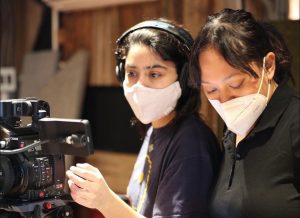
“The way that these particular students who are featured through UConn Reels were able to work together and work collaboratively on realizing these films is a real testament to the kind of community we create within the department,” says Elliott-Famularo, “and to some of the special uniqueness of the Stamford campus, in particular.”
At the Boston/New England Emmy® Awards Gala, held in Boston on June 8, Aranda won two Pillar Awards, the equivalent of a student regional Emmy®, taking the College/University – Video Essay category for “Say Something” and the College/University – Arts/Entertainment/Cultural Affairs category for “Made In Bridgeport.”
Orrico was also recognized with an Honorable Mention in the College/University – Video Essay category for “The Ladder.”
Aranda also won Best Documentary 2022 at the Bridgeport Film Festival for “Public Hazard” and the Student Documentary Award of Excellence at the BEA Festival of Media Arts 2024 for “Made In Bridgeport,” and she premiered “Say Something” at the Slamdance 2024 film festival.
“It’s always cool to accomplish something, and feel proud of something, and move forward with your work when you’re so young, because it feels like you’re on the right track,” says Aranda. “As a student, I think it’s just an extra layer of accomplishment. I did it, and I’m just a student. Imagine what I could do when I’ve done it for a while.”
It was also, Aranda says, an acknowledgement of her identity – something critically important to her and deeply apparent in all of her work.
“I’m a Paraguayan American multimedia artist and filmmaker from Bridgeport, Connecticut,” she says. “All these layers, that’s all me, and every single layer comes into every moment of my work. That could be good or bad, because it’s the way I navigate the world and a way that other people don’t navigate the world. So, all of these proud and public acknowledgements of my work, its extra special for me, personally.”
It’s also special for Guerra, and for the program he, Elliott-Famularo, and their colleagues are nurturing in Stamford – a young program, not even technically its own major at UConn, that’s already competing with larger, more established film programs in the Northeast region.
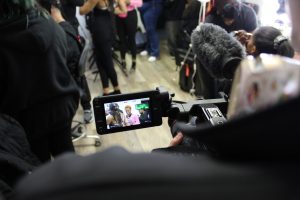
“A night like that one was a night of a lot of satisfaction and a lot of pride, to see them thrive,” says Guerra, who was in Boston with Orrico, Aranda, and Gray as they accepted their Pillar Awards for their student work. “And also, for us as educators, to know that what we do has some impact.
“Sometimes, you don’t get to see that at all, and that’s what we do as educators – you plant a seed that you’re not going to get to see grow. But on some rare occasions, like this, you do actually get to see it bloom.”
The second season of UConn Reels, which will include short films produced by a new cohort of students from UConn, is slated to air on Connecticut Public this coming fall.
